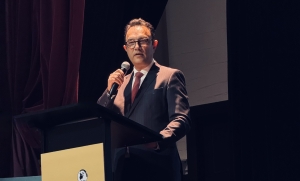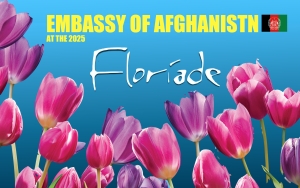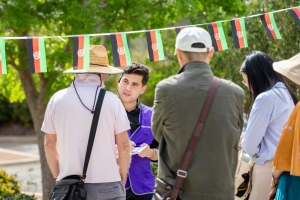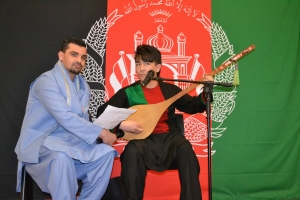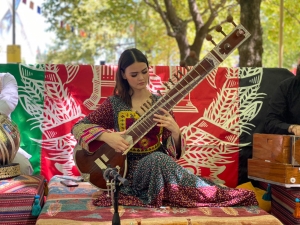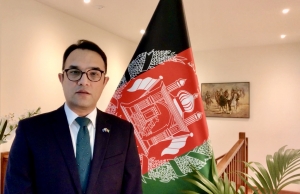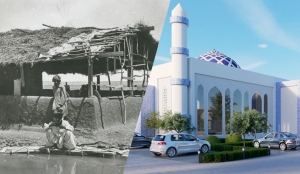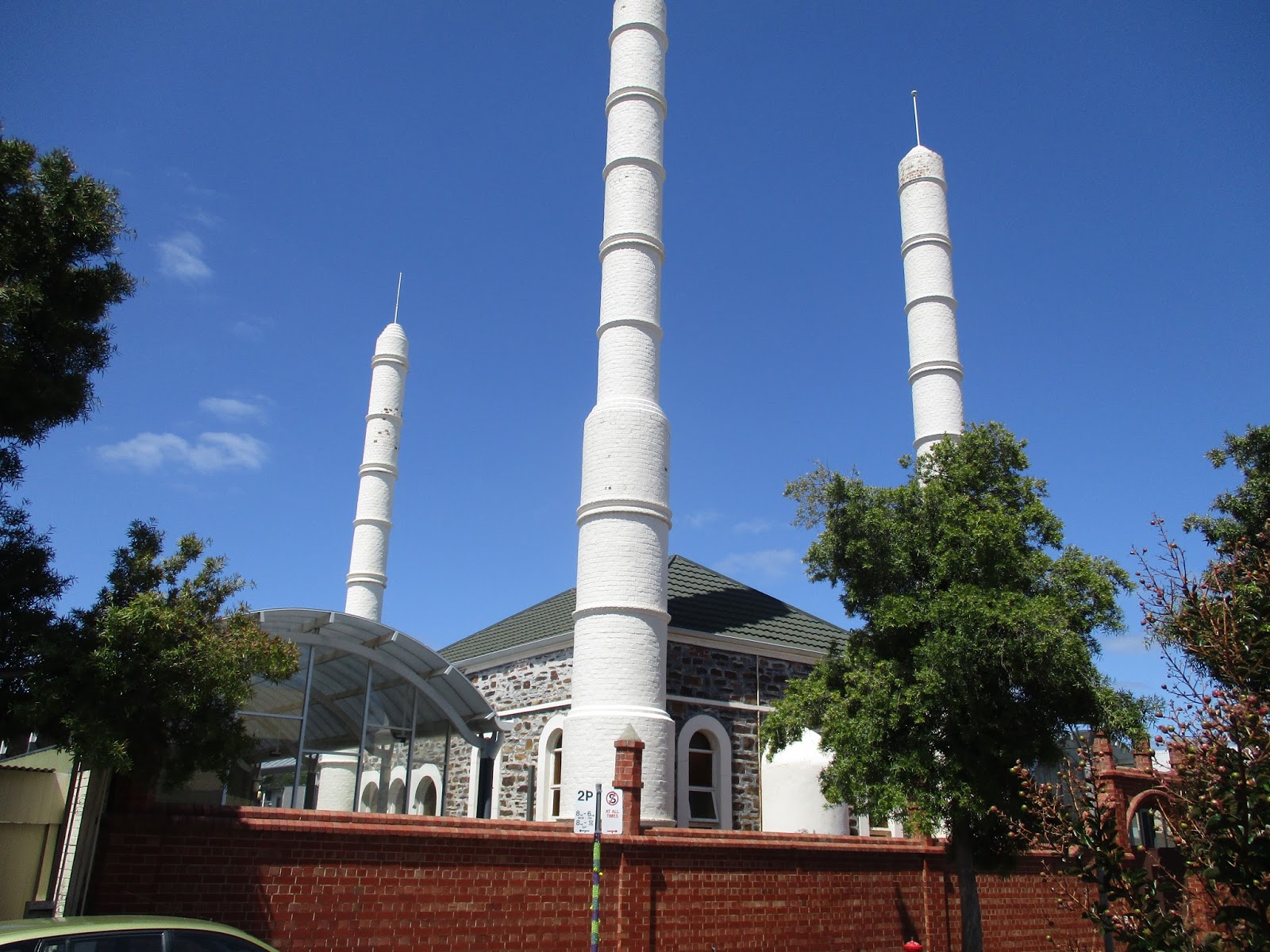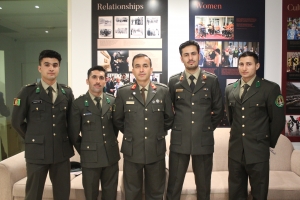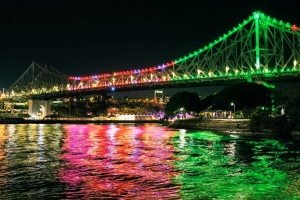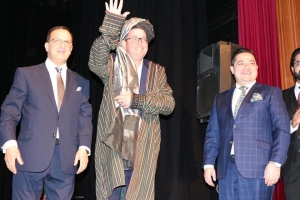Fundraising for Kunar's Earthquake in Sydney
The Embassy of Afghanistan in Canberra was honored to participate in the fundraising dinner hosted by the HADIA Foundation at Granville Town Hall on 13 September. Ambassador Wahidullah Waissi delivered the keynote address, expressing solidarity with the victims of the devastating earthquakes in #Kunar province.
“We are gathered here tonight with heavy hearts. Behind every number is a face, a story, a mother, a father, a child who will not see tomorrow. It is not just a tragedy for Kunar, it is a wound for the whole of Afghanistan, and for Afghans everywhere. In moments like this, we are reminded of the fragility of life, but also of the strength of solidarity,” the Ambassador said.
Ambassador Waissi added, “Our community in Australia has always carried Afghanistan in its heart. We celebrate its beauty and culture, and today, we share its pain. The people of Kunar are not asking us for words of sympathy alone, they are asking us for action and for hope.”
The event brought together over 250 attendees from across the Afghan and wider Australian community and successfully raised around AUD 60,000 to support humanitarian relief efforts. The Embassy commends the Hadia Foundation’s decade-long record of humanitarian service and extends gratitude to all who contributed generously to this vital cause. ????
Afghanistan in Floriade - Canberra, 11 October 2025
As a vibrant lead-in to the main Windows to the World weekend, the Embassy of Afghanistan is proud to join the special showcase on Saturday 11 October at Commonwealth Park during Floriade. A selection of embassies, including Afghanistan, will host pop-up displays, offering visitors a glimpse into the rich cultures and experiences featured in the upcoming program.
At the Afghan display, visitors will have the chance to:
-
Explore a display of Afghan artifacts and traditional clothes
-
Discover Afghan fashion design
-
Enjoy the sounds of the Rubab, the national instrument of Afghanistan
-
Taste dry fruit and saffron tea, alongside authentic Afghan food and drinks
It is a unique opportunity to experience the beauty, creativity, and diversity of Afghanistan while travelling the world in a single day at Floriade.
More details can be accessed from here: https://floriadeaustralia.com/program/windows-to-the-world-at-floriade/
Windows to the World further opens doors to Canberra’s embassies and high commissions, where visitors can explore international architecture, gardens, culture, and traditions without leaving the capital. This year, Windows to the World returns on Saturday 18 and Sunday 19 October 2025, and the Embassy of Afghanistan is honoured to take part in this celebration of global friendship and cultural exchange.
Embassy of Afghanistan in Canberra's Cultural Showcase: A Resounding Success at WTTW 2023
The Embassy of Afghanistan in Canberra recently held a remarkable event at WTTW 2023, drawing an impressive crowd of 1255 visitors. This event, a celebration of Afghan art and culture, was not only a testament to the embassy's commitment to upholding its diplomatic responsibilities under the Vienna Convention of Diplomatic Relations of 1961 but also a significant step in operating independently of Taliban influences.
Visitors were immersed in a variety of activities and exhibitions that highlighted the rich heritage of Afghanistan. The sale of Afghan carpets and rugs was a highlight, with proceeds going to support earthquake victims in Herat. The exclusive exhibition of "Making Marks" Handkerchief Artworks by Afghan women, courtesy of the Australian War Memorial, offered a unique insight into the resilience and creativity of Afghan women.
The embassy's cultural artefacts were on display, providing an immersive journey into the country's history. The Afghan Food Stall and the pairing of aromatic Saffron Tea with dry fruit tastings were particularly popular among visitors, offering a taste of traditional Afghan flavors. The event also included the joy of kite running, with hourly sessions that brought to life a beloved Afghan pastime.
An important part of the day was the "Afghan Cameleers in Australia" section, which featured an array of books and photographs, and the "Book Corner," which invited visitors to explore Afghanistan's art and culture in depth.
This successful event was recognized with a certificate of appreciation by the ACT Government, acknowledging the significant cultural contribution of the Embassy of Afghanistan in Canberra. It served as an important cultural bridge, connecting communities and enhancing understanding and appreciation of Afghan traditions and history.
To see photos of the event, please visit the following link HERE.
Afghan Independence Day in Auckland: A Fusion of Historical Reverence and Contemporary Engagement
On 20th August 2023, the Afghan diaspora in Auckland congregated in a grand celebration of the 104th anniversary of Afghanistan's Independence Day. This jubilant event, attended by numerous community members and distinguished Kiwi guests, served not only as a commemoration of the historic day but also as a beacon of unity and collective reminiscence. Among the esteemed attendees were NZ parliamentarians Phil Tywford, Michael Wood, Helen White, and Paulo Garcia.
The occasion was ceremoniously inaugurated with the heartfelt recitation of the Holy Quran, followed by the resonant playing of the national anthem of the Islamic Republic of Afghanistan. Naqib Miyakhil, the chairperson of the Afghan Association, greeted the audience, setting the tone for the evening. Yasin Hotaki, the Honorary Consul, delved deeper into the significance of the day, recounting the valor of King Ghazi Amanulla Khan and echoing Phil Tywford MP's sentiment on the trailblazing efforts of King Amanullah and Queen Soraya. Their visionary steps in 1919, which encompassed a constitution advocating universal education and women's suffrage, showcased a reformist spirit that, though unsettling for the British Empire, remains a cornerstone of Afghan pride.
Phil Tywford MP's reflections enriched the narrative, emphasizing the night's dual purpose: "Afghan Independence Day is a moment to remember the great reformers King Amanullah and Queen Soraya... It was great to remember that history at a well-attended celebration." Beyond the cultural delicacies, music, and speeches, the event resonated with a strong democratic undercurrent. The Afghan Community Voter Project volunteers exemplified this spirit, registering a considerable number of voters, with Phil Tywford actively participating in the enrollment process.
The evening, encapsulating a harmonious blend of historical pride and contemporary civic engagement, culminated in a delectable Afghan dinner and an enthralling performance of the national dance. Through such events, Auckland's Afghan community reaffirms its commitment to preserving its rich heritage while actively participating in New Zealand's democratic fabric.
Afghanistan's Multicultural Triumph: Canberra 2023
Message from Afghan Ambassador HE Wahidullah Waissi
بسم الله الرحمن الرحیم
I am honoured to deliver this statement on the occasion of 101 anniversary of Afghanistan’s Independence Day. Despite COVID-19 disruption, I am grateful for all of you for making your time in joining us to the virtual celebration of this historic event.
I would like to begin with a message of sympathy with the families and friends of those who have lost their loved ones during this unprecedented pandemic. I also wish quick recovery to the affected ones. As the cure has not developed, the virus still hits cities, disturbs economies and changes the pattern of our lifestyles. Let me thank all those men and women who serve as medical staff, essential workers and security personnel who made big sacrifice during this difficult time while the rest of us stayed safe at homes.
The Embassy of the Islamic Republic of Afghanistan in Canberra is excited to celebrate the independence day across different cities in Australia, New Zealand and Fiji and engage members of all communities to join in the virtual activities while we observe COVID-19 regulations.
A century and a year ago in 19 August 1919, Afghans under the leadership of King Amanullah reclaimed Afghanistan’s independence. The reformist and visionary King set the foundations of modern Afghanistan on democracy, freedom, rule of law, gender equality and other constitutional values to which the Afghan nation still continue to fight and resist for to sustain and safeguard those values.
Last year both Afghanistan and Australia celebrated its 50 years of diplomatic relations through a series of successful events in deferent states of Australia as well as in Kabul. However, 2020, marks an extra special occasion as it observes the 160th anniversary of the arrival of Afghan cameleers to Australia, whose history and legacy the Embassy has been sharing this year. The contributions of these cameleers and their descendants is a true testament to the mutual friendship shared by Afghanistan and Australia. On this 101st Independence Day the Embassy will be carrying their message of peace and prosperity, and looks forward to the next chapter of Afghanistan’s future.
Afghanistan and Australia enjoy a steadfast bilateral and multilateral engagement. Since 2001, Australia’s partnership with Afghanistan has scaled up at different levels from security to economic development, health, education and women empowerment. Let me briefly reflect on the generous support and assistance of New Zealand to Afghanistan as well. Since 2003, New Zealand’s contribution in security and development sectors in Afghanistan has been substantial.
په آسترالیا، نوی زیلاند او فیجی کی میشت گرانو هیوادوالو:
تاسو ټولو ته زموږ د ګران هیواد د خپلواکۍ د بیرته اخیستلو کلیزې مبارکي وایم او په تیر کال کې د افغانستان او آسټرالیا د سیاسي اړیکو د پنځوسمی کلیزی د لمانځلو په برنامو کې د همکارو اتحادیو فعال ګډون او برخه اخیستنه او د سږ کال د هیواد د خپلواکۍ کلیزې په لمانځلو کې ستاسو له هڅو څخه په کلکه مننه کوم.
با استفاده از این فرصت اجازه دهید دو پیام جداگانه برای شما داشته باشم:
نخست طوریکه میدانید حفظ استقلال ، تمامیت ارضی و حاکمیت ملی افغانستان در طول تاریخ همواره سرخط کار دولت و ملت وطندوست افغانستان بوده است. طی دو دهه اخیر کشور ما حضور نظامی و مساعدتهای توسعه یی جامعه بین المللی را طبق تصامیم شورای امنیت سازمان ملل متحد و سایر نهاد های جهانی شاهد بوده است.
دولت جمهوری اسلامی افغانستان در حالیکه از فداکاری ها و مساعدت های شرکای بین المللی خود به شمول آسترالیا در مبارزه علیه تروریزم و افراطیت اظهار امتنان نموده و می نماید، از بدو حضور این نیروها و مساعدت های جامعه بین المللی گذار بسوی خود کفایی را در تمام برنامه های اولویت ملی خود مد نظر داشته و مجدانه آنرا تعقیب نموده و می نماید.
از جنوری سال ۲۰۱۵ بدینسو بار مسولیت دفاع از قلمرو، تمامیت ارضی و حاکمیت ملی افغانستان و رهبری تمام عملیات های رزمی بدوش نیروهای دلیر دفاعی و امنیتی کشور قرار دارد.
در عرصه اقتصادی نیز دولت افغانستان برنامه ها و پروژه های بزرگ اقتصادی و توسعه یی را درجهت کاهش فقر و نیل به توسعه اقتصادی در کشور طرح و تطبیق نموده و می نماید.
دوهم دا چی، سږکال په آسټرالیا کې د اوښبه افغانانو د لومړۍ ډلې د رارسیدو 160 کليزې سره برابر دی چې په 1860 کال کې دی براعظم ته راغلی و.
اوښبه افغانان هغه لومړني خلک وو چې اسلام یې آسترالیا ته راوړه.
هغوی د ژوند کولو لپاره نه یواځې د غان ټاونونو په نوم د اوسیدو لپاره ښارګوټي جوړ کړل، بلکه د غان په نوم د لومړي اورګاډي پټلۍ د جوړولو له لارې د براعظم د مختلفو برخو په پراختیا او اقتصادي ارتباط کې هم رول لوبولی.
د کووید۱۹ د محدودیتونو له امله، د افغانستان سفارت په دې مناسبت د خپل ټولنیز رسانی له لارې دا مهمه او تاریخي پیښه ولمانځله ترڅو دا مثبت پیغام ورسوي چې پدې هیوادونو کې د افغان کډوالۍ مثبت اړخونه حساب کیدی شي.
افغان دایاسپورا په آسټرلیا، نیوزیلینډ او فیجي کی د عامه اړیکو ژور او پراختیا کې رغنده رول لوبوي.
هریک شما در حقیقت سفرای فرهنگ، تاریخ، هنر و سایر داشته ها و ارزشهای ملی خود در کشور های میزبان هستید.
هر سال ما شاهد افتخارات بیشتری از افغانهای هموطن خود در عرصه های مختلف می باشیم و امید واریم این سلسله ادامه یابد.
همکاری شما در موفقیت برنامه های ملی مربوط به افغانستان مایه دلگرمی و افتخار است.
In conclusion, we are grateful to our International partners in particular Australia and New Zealand who are standing with us with courage and dedication bearing much sacrifices during difficult times of resilience. Our commitments to democracy and human dignity set forth in our Independence reclamation in 1919 remained unchanged. Safeguarding the gains, we jointly have had so far with the support of international community in the past 19 years in Afghanistan is vital.
Afghans, Islam and Australia: From Cameleers to the Present Day
Afghans, Islam and Australia from cameleers to the present day
Written and researched by Pamela Rajkowski OAM
Introduction
Aside from some pre-colonial contact between Makassan traders and the Aboriginal Yolgnu people in Arnhem Land, the start of Islam’s permanent presence in Australia was in the 1860s, with the arrival of Afghan cameleers who came and worked in the Australian outback as explorers and exporters. Large scale immigration of non-European Muslims to Australia only started with the dismantlement of the White Australia Policy, and the encouragement of multiculturalism. As of the 2016 census, Islam is the second largest religious grouping in Australia, with 604 200 Muslims living in Australia, or 2.6 percent of the population.
Afghan cameleers' mosques across Australia
The first four cameleers on Australian soil arrived in 1860 to assist on the Victorian government’s Burke and Wills expedition. These four Mohammedans [the universal term used until about the 1920s when it was replaced with Muslim or Islamic] and the camels originated from Peshawar, north-east India. After 1861 they did not establish any community.
1866 marks the arrival of the first commercial importation, funded by Thomas Elder of Beltana Station in South Australia, of 32 cameleers and 121 camels. The camels were purchased in camel markets in the Scinde and Rajasthan, and Kandahar in Afghanistan. The cameleers, contracted in the Scinde, Rajasthan and Afghanistan, were predominantly of Afghan descent and Moslem. Elder imported more Afghan cameleers and camels in 1884 and in 1893 to be used in South Australia, the Northern Territory and Western Australia. In the 1880s to 1910s Afghan camel merchants were travelling back to India and Afghanistan to purchase and import more camels and cameleers to work in New South Wales, Queensland and Western Australia. By the 1890s there were estimated to be about 1,000 Afghan cameleers in Western Australia and by 1901 3,000 overall in Australia.
The cameleers set up regular camel transport routes radiating out from depots in remote central locations and at railheads and married local women and set up families in Afghan camps or “ghan towns”. By the 1880s these Moslem haulers commenced erecting their spiritual centres, mosques, in their ghan camps or towns, in colonies across Australia. Camel community leaders or “jemidahs” or camel merchants required camel drivers to contribute to finance building the mosques frequently made of frail materials including wooden slabs or poles, mud walls, galvanised iron sheets and grasses for rooves. The call by the muezzin to prayer was heard from the 1880s to about the late 1920s across the outback. Eventually with more wealth accumulated in the cameleers’ population three large, permanent mosques were constructed. Today, the three permanent mosques are active, while the more remote mosques have been preserved or have disappeared. In total, about 16 mosques were erected across Australia by cameleers’ funds between 1884 and 1930s.
There were distinctive common characteristics noted in the Afghan cameleer mosques across Australia. Between the 1880s to the 1920s reporters, authors and travellers, such as in Coolgardie and Marree, recorded hearing the sound of the “call of the muezzin to prayer” across towns. There was no furniture in the interior of mosques. The faithful prayed on their prayer mats. No shoes were worn into the mosque. A “pond” or trough provided a source of water for ablutions. Inside a niche in the walls held the Koran. A picture of Mecca hung in each mosque. Particularly in the 1890s to 1910 a number of mullahs acting as “visiting priests” or “missionaries” sailed from Karachi to serve their distant faithful, at least in South Australia and Western Australia, who were far from home. As at the Adelaide and Broken Hill mosques there would be a separate smaller building, a kitchen. This was used for visiting mullahs, or holy men such as “sayids”, from distant countries or desert settlements visiting city mosques, and for cooking community feasts after the end of Ramadan. Trees such as date palms or fruit trees were planted in the grounds adjacent to the mosques. Today, the surviving mosques, active or preserved as historical memorials, built and funded by the Afghan cameleers, are visited by Australian tourists and overseas visitors. They are a part of the cameleers’ legacy and of Australia’s heritage.
South Australia
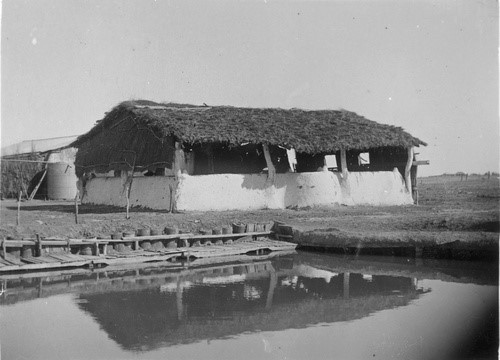 Marree/Hergott Springs: The “Ghan town” at Hergott Springs in northern South Australia was found by cameleers who moved from the camel depot at Beltana station to establish a new camel depot closer to the interior of the continent where camel transport was in great demand. By the 1870s the largest cameleer Ghan town in South Australia and Australia was known as “Little Asia” or “Little Afghanistan”. The site of the first Hergott Springs mosque, built in about 1884, was near natural springs or artesian water away from the town and on “Faiz Mahomet’s pad”. The building was a crude, rectangular structure of hand-made low bisque clay or mud walls, timber sticks as supports, and a cane thatched roof. The advantage of open walls was to allow breezes to cool the men at prayer during hot summer months. Nearby was the ablution pool filled with water supplied by an irrigation pipe system built by the wealthy camel driver and trader Sheik Abdul Kader. Wooden steps lead the washed worshippers from the pool to the entrance of the mosque. The spiritual leader was Mullah Assam Khan whose birthplace was Peshawar, located between Afghanistan and India. Date palms were planted near the ablution pond. This building lasted until about 1901.
Marree/Hergott Springs: The “Ghan town” at Hergott Springs in northern South Australia was found by cameleers who moved from the camel depot at Beltana station to establish a new camel depot closer to the interior of the continent where camel transport was in great demand. By the 1870s the largest cameleer Ghan town in South Australia and Australia was known as “Little Asia” or “Little Afghanistan”. The site of the first Hergott Springs mosque, built in about 1884, was near natural springs or artesian water away from the town and on “Faiz Mahomet’s pad”. The building was a crude, rectangular structure of hand-made low bisque clay or mud walls, timber sticks as supports, and a cane thatched roof. The advantage of open walls was to allow breezes to cool the men at prayer during hot summer months. Nearby was the ablution pool filled with water supplied by an irrigation pipe system built by the wealthy camel driver and trader Sheik Abdul Kader. Wooden steps lead the washed worshippers from the pool to the entrance of the mosque. The spiritual leader was Mullah Assam Khan whose birthplace was Peshawar, located between Afghanistan and India. Date palms were planted near the ablution pond. This building lasted until about 1901.
After the first mosque became dilapidated the cameleers built by 1910 a second thatched roof mosque, called the “Mahomadan temple”. It had a larger ablution pool, a water tank, a wooden pole lined platform for standing on to do ablutions, and some brush fencing. It was located closer to Sheik Abduk Kader’s date plantation. Inside the floor was carpeted and prayer mats laid on the carpet. This building was used until the 1920s when it was replaced by the third mosque.
First mosque in Hergott Springs [Marree] on “Faiz Mahomet’s pad”. Source: Pamela Rajkowski OAM
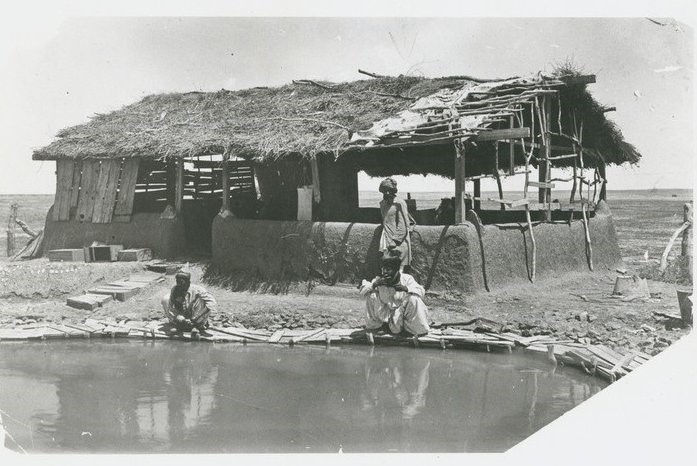
By 1920 the Afghan cameleers funded a third mosque made of more permanent materials, such as walls of galvanised iron sheets and pine poles, a pitched iron roof and a wood lined ablution pool. A verandah over the entrance was shaded by tall trees. When this mosque became disused it was pulled down. Local Afghan descendants recycled the sheets of galvanised iron in their own homes in Marree’s Ghan town. The carpets were taken to the Afghan mosque in Adelaide.
The second mosque in Marree built closer to Sheik Abdul Kader’s date plantation. Source: State Library of South Australia https://collections.slsa.sa.gov.au/resource/B+1534

In the early 1930s the Marree holy man Syed Goolamadeen, in white, stands beside the ablution pool of Marree’s iron mosque. Photo Source: Pamela Rajkowski OAM
Since the 2010s in Marree a replica of the first mosque stands in the second main street on the Ghan side of the town. It was a project from funds raised by Afghan cameleer descendants.
The replica of the first mosque in Marree’s second main street.
Adelaide
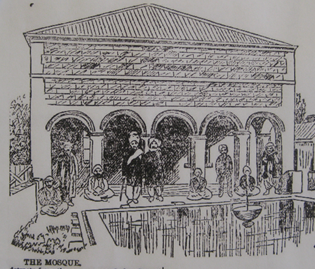 The “jemidar” of the first cameleers to arrive at Beltana station in 1866, Faiz Mahomet of Kandahar, also eventually an owner of camel strings and camel importer and employer of cameleers, managed the Afghan cameleers at Beltana station and at Hergott Springs from the 1870s to 1880s. Seeing that many would be permanently residing in Australia he wanted to provide them with a permanent mosque, a “home away from home”, as a spiritual centre where they could receive charity and care. In 1887 Faiz Mahomet purchased a piece of land for 450 pounds from the Adelaide City Corporation in Little Gilbert Street in the south-west corner of Adelaide. The square blue stone building with a stately dome was constructed over two years and opened in 1890. The grounds included an ablution pool with a fountain in its centre. Hadji Mullah Merbain, born in Kandahar, came from Coolgardie to be the first mullah in the Adelaide mosque. As the mosque’s mortgage was unlikely to be paid off in its two year time limit in 1893 Abdul Wade / Wadi, another wealthy camel merchant, camel importer and employer of cameleers in New South Wales, paid off the mosque’s mortgage debt with 293 pounds so that the mosque stayed in the hands of his fellow countrymen. He became the trustee of the mosque.
The “jemidar” of the first cameleers to arrive at Beltana station in 1866, Faiz Mahomet of Kandahar, also eventually an owner of camel strings and camel importer and employer of cameleers, managed the Afghan cameleers at Beltana station and at Hergott Springs from the 1870s to 1880s. Seeing that many would be permanently residing in Australia he wanted to provide them with a permanent mosque, a “home away from home”, as a spiritual centre where they could receive charity and care. In 1887 Faiz Mahomet purchased a piece of land for 450 pounds from the Adelaide City Corporation in Little Gilbert Street in the south-west corner of Adelaide. The square blue stone building with a stately dome was constructed over two years and opened in 1890. The grounds included an ablution pool with a fountain in its centre. Hadji Mullah Merbain, born in Kandahar, came from Coolgardie to be the first mullah in the Adelaide mosque. As the mosque’s mortgage was unlikely to be paid off in its two year time limit in 1893 Abdul Wade / Wadi, another wealthy camel merchant, camel importer and employer of cameleers in New South Wales, paid off the mosque’s mortgage debt with 293 pounds so that the mosque stayed in the hands of his fellow countrymen. He became the trustee of the mosque.
Cameleers funds financed the extensions of the Adelaide mosque. Camel drivers gave ten shillings a year and camel merchants gave one pound a year. By 1901 to 1903 funds, including a significant amount donated by Basha Gool, a Western Australian camel owner, afforded the addition of four red brick minarets, painted white, and a high red brick wall.
The Adelaide mosque or “Afghan chapel” was the first permanent mosque in Australia, the first city mosque and is the oldest permanent mosque in Australia.
By the 1940s the population of Afghan cameleers declined, and their sons took on different occupations, so there was no need for more Afghan cameleers to migrate to Australia. Few followers of the Moslem faith visited the Adelaide mosque. From the 1950s the congregation of the Adelaide City mosque was boosted by Muslims arriving from Bosnia, Yugoslavia, Pakistan, Africa and Indonesia.
The Adelaide mosque sketched in July 1890. Hadji Mullah Merbain, with a tall white turban and walking stick, stands near the centre. Four minarets were added in 1901 – 4. Source: Pamela Rajkowski OAM
Today the Adelaide City mosque, seen here with the white painted minarets and tall red brick wall, is state heritage listed. Source: Pamela Rajkowski OAM
Western Australia
Coolgardie: The development of the Western Australian goldfields in the 1880s and 1890s attracted hundreds of Afghan cameleers and camels. Jemidar Faiz Mahomet, Tagh Mahomet and other South Australian cameleers travelled to the goldfields and eventually independent camel owners sailed to Karachi to collect camels with camel handlers to bring into Western Australia. By 1892 the growing population of Afghan cameleers built two mosques in Coolgardie and they had two mullahs. The first mosque in their Afghan camp at Fly Flat at the eastern end of Coolgardie, the largest centre in the goldfields, was financed by Faiz Mahomet. Tagh Mahomet, his brother, and Goulam Mahomet were joint owners of the mosque. The mullah of the first mosque was a Kandahar man, Hadji Mullah Merbain. Later its gardener was another Kandahar man, Goulam Rassoul. Steps led to the entrance of its galvanised iron structure and a trough provided water for ablutions. If there was no water in the ablution trough because of extremely hot weather the faithful washed themselves with sand.
In 1987 Faiz Mahomet brought out a priest Mullah Il Lasman who had sailed from Karachi to say prayers in front of 200 “Mohammedans” squatted on carpets and prayer mats. Above the faithful was “a flag bearing the star and crescent “. After the service Faiz Mahomet provided a feast for his visiting mullah and congregation
The second mosque was based in the “Beloochi camp”. Its mullah, Mullah Mirza Khan, could deliver services in four languages [three were Arabic, Parsee, Pushtun or Afghan]. In 1897 after his service a banquet was organised for the congregation by Sirdar Abdul Baki, related to Faiz Mahomet and both related to the Ameer of Afghanistan. No photos survive of either of the two mosques in Coolgardie. [Coolgardie Miner, WA, 8 March 1897, pg 6, “Mahommedan festival, Afghan rejoicings.”]
Between the 1890s to the 1910s the large and dispersed cameleer communities had built seven small mosques across the goldfields. In 1910 the Collector of Customs, based in Fremantle, Perth’s port town, recorded mosques built near mining settlements distributed throughout the goldfields which had Afghan camel depots or camps. These were in Coolgardie [two], Mount Malcom, Leonora, Mount Magnet, Bummers Creek and Mount Sir Samuel. The Perth mosque made the eighth mosque in Western Australia.
Perth: The cameleers’ first permanent mosque in Western Australia, and the second such one in Australia, was located in Perth. It was designed and built between 4 June 1904 and 1906. By the 1890s Faiz Mahomet operated many camel strings from his five offices across the goldfields and employed many Afghan cameleers. Faiz Mahomet played a key role in founding the first permanent mosque in Western Australia. He provided funds to purchase a piece of land for 680 pounds in William Street in the city of Perth. The building of the “Mohammedan mosque” was supervised by Muhamed Hassan Musa Khan, another jemidah and principal Afghan boss of the camel men of the Coolgardie goldfields, and created by the Kandaharian Mahomet Allum. Faiz Mahomet collected funds from the goldfields cameleers to finance the building of the mosque. The structure of a rectangular building included a second storey, gilt tipped mouldings and steps up to a verandah. It was surrounded by a high wall.
On 13 November, 1905, Faiz Mahomet, initiator and financier of at least four mosques, two being Australia’s first two permanent mosques, that served the far flung cameleers Muslim community which was far from their homelands, and highly respected by the head of state of Afghanistan, Emir of Afghanistan, laid the foundation stone. The Emir Habibullah Khan was appointed trustee of the Perth mosque. Later both the building and the high wall surrounding the mosque were painted white. The Perth mosque was heritage listed in 1995. It has a vibrant congregation today.
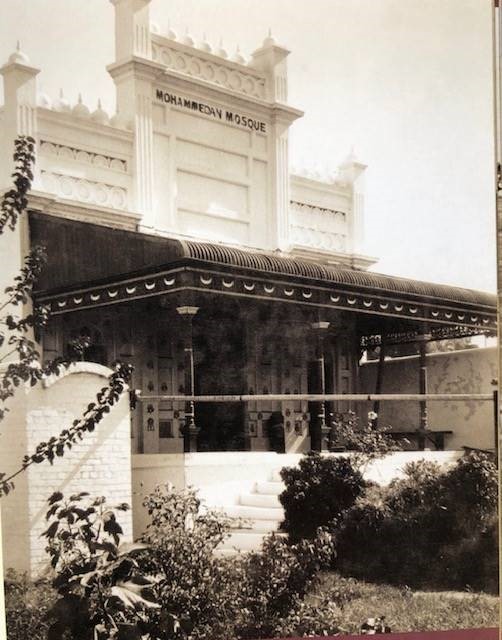
The Perth Mohammedan mosque pictured in the 1930s. Source: Pamela Rajkowski OAM
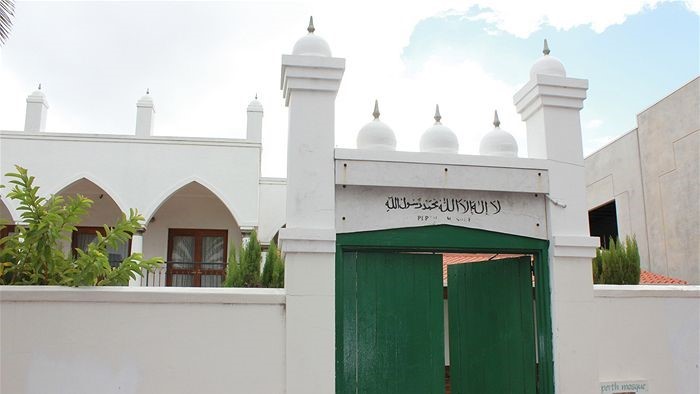
Perth mosque as it was painted in the 1970s. Source: ABC https://www.abc.net.au/local/photos/2012/04/12/3476007.htm
New South Wales
Broken Hill: Broken Hill had a larger North Camel Camp and a smaller West Camel camp and a mosque in each. The mosque in the North Camel Camp in Broken Hill was erected between 1887 to 1891. It was near a running stream which provided the worshippers with water for their ablutions. The men washed their feet over a ground level cement trough then walked on stepping-stones into the mosque. The corrugated iron and wood structure with a pitched roof was divided into two rooms, an ante room used to prepare the dead for burial and a prayer room. Prayer mats covered the floor. The mirab, the niche where the mullah stood reciting the prayers, was suggested by a painted arch on the north-west wall. In 1967 this mosque was saved from demolition by the Broken Hill Historical Society and in 2010 was placed on the NSW Heritage register. In 2018 to 2020 NSW has a restoration project underway to restore the mosque and yard and arrange its memorabilia in an added museum.
The Broken Hill’s North Camel camp iron mosque with date palms.
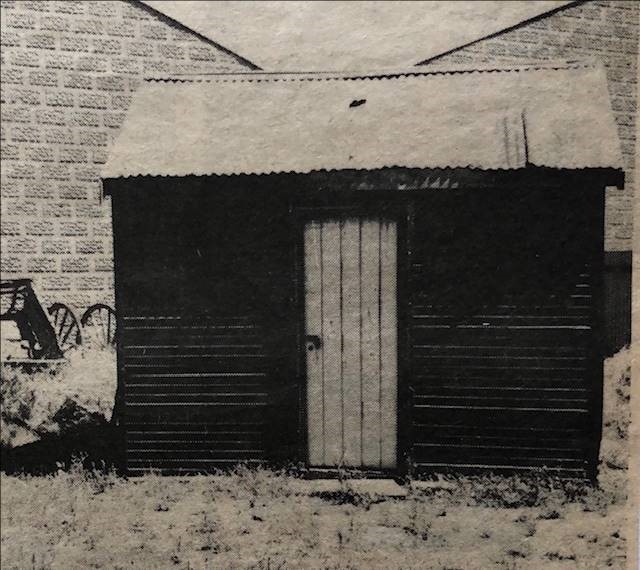
The smaller, one roomed tin and wooden mosque located in Broken Hill’s West Camel Camp. Source: Pamela Rajkowski OAM
Bourke: Bourke was the base of Abdul Wade / Wadi’s large camel carting company and many Afghan cameleers worked on routes that radiated out of that own. A camel owner Bye Khan built a one roomed, wood and galvanised iron house near the back door of the old house of Norbeen Perooz in the ghan town in Bourke. Perooz ‘s group of camelmen used the mosque. It had a pitched roof and small verandah. In 1996 the Bourke mosque was relocated from Hope Street to the Afghan section of the cemetery, in the hope of preserving it. It has been saved and is today preserved as a tourist attraction.
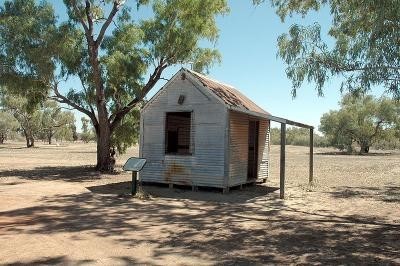
Bourke mosque. Source: Pamela Rajkowski OAM
Queensland
In the ghan town in Cloncurry in south-west Queensland the cameleers built a mosque from wooden slats. Until the late 1940s many pack saddles were seen beside the mosque. The last deed holder was Otta Khan. This mosque was pulled down after 1947 and its fruit orchard dried up.
Northern Territory
Alice Springs: The cameleers were more scattered in Alice Springs but still built a simple mosque near the camp of Satour, a significant camel merchant. It was made from timber with a thatched roof and open sides. Date palms were planted near the mosque. As it disintegrated, funds were raised for local cameleers and Moslems to build a permanent structure which still stands today. It is the third permanent mosque funded by Afghan cameleers.
Modern Afghan mosques in Australia
Blacktown Afghan Osman Mosque, New South Wales: The Blacktown Mosque, built by the Afghan community in Western Sydney, finished construction in 2014. It has since been involved in community projects for troubled youths in the Blacktown area, alongside its regular religious services.
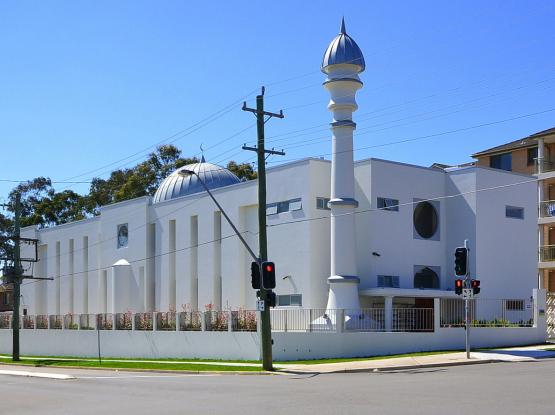
Afghan Islamic Centre & Omar Farooq Mosque, Doveton, Victoria: The already established Afghan Islamic Centre and Omar Farooq Mosque, is set to be relocated to a state-of-the-art facility in Doveton, Victoria. The new mosque, currently under construction, and is set to have large prayer, recreational, educational and conference facilities.
Photo source: Mosque Finder http://mosque-finder.com.au/mosque/blacktown-afghan-osman-mosque/
Conclusion
Today, Muslims play an integral part in Australia’s social, political and economic life. All major cities and regional hubs have notable Muslim communities from a wide range of national backgrounds, from Europe, Africa and Asia. Muslims are represented in both houses of Federal Parliament.
As of the 2016 Census, there are 46 800 Australians who reported as being born in Afghanistan. They are highly concentrated in the Ryde and Blacktown areas of Sydney, as well as Dandenong in Melbourne, where the second and third most spoken languages at home are Hazaraghi and Dari. Afghan Australians are active in political life, with Afghanistan-born Mina Zaki running in the division of Canberra in the 2019 Federal election for the Liberal Party. Afghanistan and Australia share a close relationship, with ever increasing economic and cultural ties.
Table: List of Mosques developed and owned by Australian-Afghans and their locations throughout Australia
|
Name |
Location |
Date of Construction |
|
Marree Mosque |
Marree, South Australia |
1884 |
|
Broken Hill Mosque |
Broken Hill, New South Wales |
1887 |
|
Central Adelaide Mosque |
Adelaide, South Australia |
1890 |
|
Coolgardie Mosque |
Coolgardie, Western Australia |
1892 |
|
Perth Mosque |
Perth, Western Australia |
1906 |
|
Afghan Mosque Alice Springs |
Alice Springs, Northern Territory |
1960s |
|
Blacktown Afghan Osman Mosque |
Blacktown, New South Wales |
2014 |
|
Afghan Islamic Centre & Omar Farooq Mosque |
Doveton, Victoria |
Under Construction, 2022 |
Disclaimer
This article was written and researched by historian and expert Pamela Rajkowski OAM, and added to by Ethan Vujanovic, an intern at the Embassy of the Islamic Republic of Afghanistan in Canberra. Material presented in this article is for the purpose of public awareness and learning and is only as accurate as the sources allow. The views and opinions expressed in this version are those of the authors and do not necessarily reflect the official policy or position of the Embassy of Islamic Republic of Afghanistan in Canberra or the Government of Afghanistan.
References
Text and Research by Pamela Rajkowski OAM, 28-30 April 2020
Maley, William. 2019. “Australia-Afghanistan relations: Reflections on a half-century". Australian Strategic Policy Institute.
Cover Photo Credit: IMPACT 3D/infinity render through Kabeer Azadzoy, Melbourne
Cadets Farewell Australia after Successful Completion of Courses
On Tuesday the 10th of December 2019 the Embassy of the I. R. of Afghanistan organized a farewell reception in honour of first Afghan cadets who successfully graduated from the two major Australian military and defence education institutions namely the Australian War College and Royal Military College-Duntroon.
Representatives of Australian Department of Defence, Department of Foreign Affairs and Trade, first Australian veteran and first Australian diplomat who served in Afghanistan, Director of the Asia Pacific College of Diplomacy, ANU, Deputy Minister of Haj and Religious Affairs and former deputy of Independent Directorate of Local Governance of I.R of Afghanistan were among the participants.
Ambassador Wahidullah Waissi thanked Australian Government for providing education opportunities for Afghan cadets as part of Australia's contribution in train, advice and assist of Afghan defence and security forces and emphasized on the importance and need of continuation of such contributions.
Brigadier Warren Gould, former Australian Attaché in Kabul thanked the graduates for their dedication and hard- working during their study and wished them further success in their home country.
Three Afghan cadets were graduated this year. Colonel Hassib Sediqi and Major Farid Noor graduated from Defence and Strategic Studies Course and Australian Command and Staff Course under Australian War College respectively. The third graduate was Lieutenant Mirwais Aryan who graduated from Army Officer Commissioning Course, Royal Military College (RMC). Two other Afghan cadets will graduate from RMC in June 2020.
Brisbane's Story Bridge Turns Black, Red, Green for the Afghanistan's Independence
Brisbane, 19 August 2019 - The Queensland Afghan Community Association (QACA) in collaboration with the Embassy of the Islamic Republic of Afghanistan in Canberra celebrated 100thAnniversary of Afghanistan`s Reclamation of Independence and 50 years of diplomatic relations between Australia and Afghanistan in Brisbane on 19thAugust 2019.
The commemoration was attended by a large number of Afghan community members and some Australian local officials.
Dr Rashid Mohmood, QACA President welcomed the participants and thanked Australian government for hosting Afghan communities and for assisting the people of Afghanistan in various spheres, particularly in the area of empowering women and girls and people to people bonds.
Mr. Mostainbillah Balagh, Embassy counsellor conveyed the message of HE Wahidullah Waissi, Ambassador of the Islamic Republic of Afghanistan in Canberra, on the two aforementioned historic occasions.
In the message, preservation of Afghanistan’s freedom inherited by the Afghan brave ancestors, in particular the reformist King Amanullah who gained Afghanistan’s independence in 1919 were highlighted as the responsibility of all Afghans either inside or outside of the country. The message also reflected on the shared history, endurance and future potential of long- lasting friendship between Afghanistan and Australia.
Hon Stirling Hinchliffe MP, Minister for local Governance, Minister for Racing and Multicultural Affairs of Queensland who was the special guest in the festivity praised the friendly and diverse relations between Australia and Afghanistan from diplomatic engagements to development and defence cooperation, cultural ties and sport.
The marvellous evening gathering continued with various activities including music performance, poetry, Afghan traditional cuisine and lighting up the iconic Brisbane story bridge with the colors of the Afghan flag sponsored by the Brisbane City Council.
The festive event concluded with an award- giving ceremony being presented by the Embassy counsellor to key organizers of the event.
Melbourne - 100th Anniversary of Afghanistan’s Independence
On the 19thof August 2019, Afghan communities residing in Melbourne gathered for the celebration of the 100th anniversary of Afghanistan’s reclamation of independence and the 50th anniversary of the establishment of diplomatic relations between Afghanistan and Australia. This was part of a series of events taking place across Australia, New Zealand and Fiji to commemorate both of these important anniversaries.
The event, held at Springvale Town Hall, was organised by the Afghan community in Victoria, in particular Mr Dur Mohammad Ashna and Mr Basir Qadiri, and was funded by Mr Alande Mustafa Safi, President of Paragon Business Group based in Victoria.
The gathering was well received and those who attended included Mr Daniel Andrews, Premier of Victoria, who took the opportunity to congratulate all Afghans on Independence Day and praised the contributions of Australian-Afghans to Australia's development and rich multiculturalism. Also in attendance were Mr Luke Donnellan, Victorian MLA for Narre Warren and Mr Steve Dimopoulos, Victorian Member of Parliament for Oakleigh.
Other attendees who joined in the celebration were state officials, leaders and members of the Afghan community, and many Afghans living in Melbourne, including men, women, and children of a variety of backgrounds. Minister-Counsellor Mr Mohammad Ateeq Zaki also attended, representing the Embassy of I.R. of Afghanistan in Canberra.
The event began with all guests joining to stand and honour the victims of the abhorrent terrorist attack in Kabul on Saturday the 17thof August. A minute’s silence was observed before the national anthems of Australia and Afghanistan were played. The flag of Afghanistan was also hoisted.
The Embassy wishes to express its appreciation to the organisers and participants of the event and the ongoing support of Afghan communities in Victoria, and their contribution to the promotion of bilateral relations and the mutual friendship between Afghanistan and Australia.


